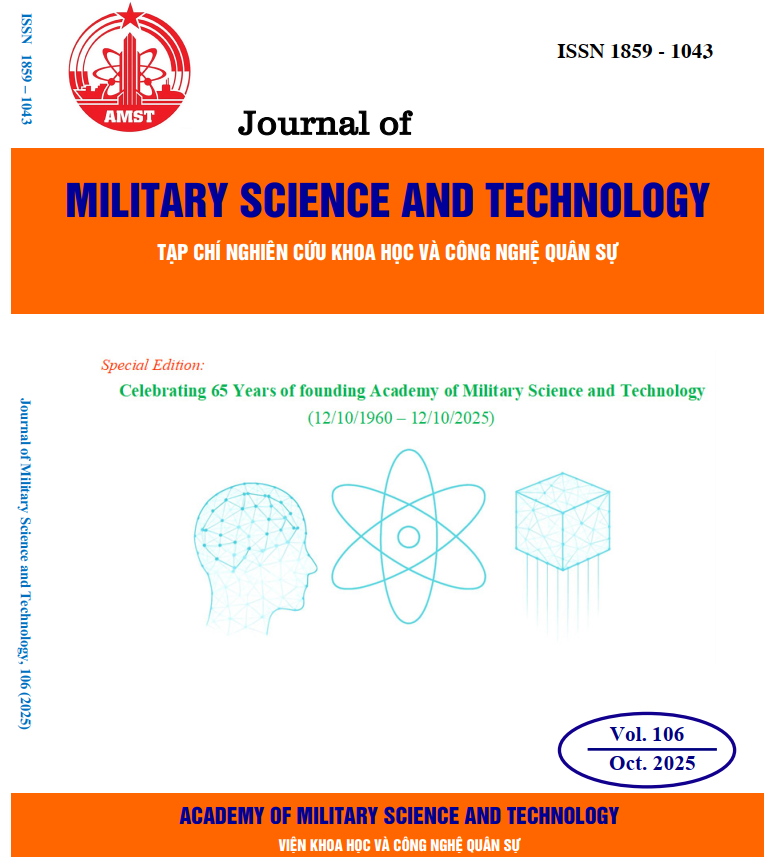Study on the effects of temperature, deposition cycle number, and cobalt additives on the properties of the positive active material in nickel-cadmium batteries
211 viewsDOI:
https://doi.org/10.54939/1859-1043.j.mst.106.2025.87-93Keywords:
Nickel–cadmium (Ni–Cd) batteries; Cobalt (Co) additives; Deposition temperature; Deposition cycles.Abstract
This study investigates the effects of deposition temperature, number of deposition cycles, and cobalt (Co) additives on the structural and electrochemical properties of the positive active material in nickel–cadmium (Ni–Cd) batteries. The purpose is to optimize fabrication parameters to enhance material utilization efficiency and battery performance. Electrodes were fabricated by impregnating porous nickel substrates with nickel nitrate solution, followed by chemical conversion in potassium hydroxide under varying temperatures (65 – 80 °C) and repeated for different cycle numbers (1 – 5). A cobalt nitrate post-treatment was applied to selected samples. Scanning Electron Microscopy (SEM), Energy Dispersive X-ray Spectroscopy (EDS), and hydrostatic weighing methods were employed to characterize microstructure, composition, density, and porosity. Charge–discharge performance was evaluated using prototype Ni–Cd cells. Results show that the optimal deposition temperature range is 70 – 75 °C, which promotes uniform active material distribution and high density while maintaining sufficient porosity. Four deposition cycles yielded the best balance between mass loading and structural stability. The addition of cobalt improved utilization efficiency by approximately 5.2% and reduced internal resistance from 7.15 mΩ to 4.85 mΩ. These findings provide a scientific basis for improving Ni–Cd electrode fabrication, and future studies may explore long-term cycling behavior and alternative conductive additives.
References
[1]. Linden, D., & Reddy, T. B. “Handbook of Batteries” (3rd ed.), McGraw-Hill, (2002).
[2]. Wu, J. B., et al. "Synthesis of nanoscale CoO particles and their effect on the positive electrodes of nickel–metal hydride batteries", International Journal of Hydrogen Energy, 32, 606–610, (2007). DOI: https://doi.org/10.1016/j.ijhydene.2006.06.044
[3]. Matsuda, H., & Ikoma, M. "Nickel/metal-hydride battery for electric vehicles", Electrochemistry, 65, 96–100, (1997).
[4]. Watanabe, K., Koseki, M., & Kumagai, N. "Effect of cobalt addition to nickel hydroxide as a positive material for rechargeable alkaline batteries", Journal of Power Sources, 58(1), 23–28, (1996). DOI: https://doi.org/10.1016/0378-7753(95)02272-4
[5]. Zhang, W., Huang, L., & Fang, Y. "Recent progress in Ni-Cd battery electrode materials: performance enhancement and mechanisms", Batteries, 7(2), 22, (2021).
[6]. Wang, J., Xie, F., & Sun, D. "Advances in cobalt-modified nickel hydroxide materials for battery applications", Journal of Power Sources, 451, 227796, (2020).
[7]. Zhou, L., Feng, Y., & Tang, B. "Stability of NiOOH phases in cobalt-doped electrodes for Ni-based batteries", Electrochemical Science Advances, 2(4), e2100135, (2022).
[8]. Kim, S. H., Nguyen, T. V., & Lee, J. Y. "Electrochemical performance of cobalt-doped Ni(OH)₂ in alkaline batteries", Electrochimica Acta, 410, 139913, (2022).
[9]. Liu, Y., et al. "Effect of thermal treatment on structural and electrochemical properties of nickel-based electrodes", Materials Chemistry and Physics, 295, 127069, (2023).
[10]. Tang, Y., Hu, W., & Duan, Y. "Redesigning Ni-based electrodes for extended reliability in high-stress environments", Energy Storage Materials, 59, 143–153, (2023).
[11]. Ivanov, V., et al. "Enhanced thermal stability of Ni-Cd battery electrodes for aerospace applications", Journal of Power Sources, 482, 228964, (2021). DOI: https://doi.org/10.1016/j.jpowsour.2020.228964
[12]. Гудимов, Н. Л., и др. "Способ изготовления окисноникелевого электрода для щелочного аккумулятора", Патент RU 2 176 425 3 С2.
[13]. Dao, T. N., et al. "Nghiên cứu lựa chọn một số điều kiện trong chế tạo vật liệu chổi than sử dụng trên tàu hải quân", Journal of Military Science and Technology, Special Issue (Institute of Chemistry and Materials), 69–76, (2020) (in Vietnamese).
[14]. Nathira Begum, S., et al. "The influences of some additives on electrochemical behaviour of nickel electrodes", International Journal of Hydrogen Energy, 34, 1548–1555, (2009). DOI: https://doi.org/10.1016/j.ijhydene.2008.11.074







